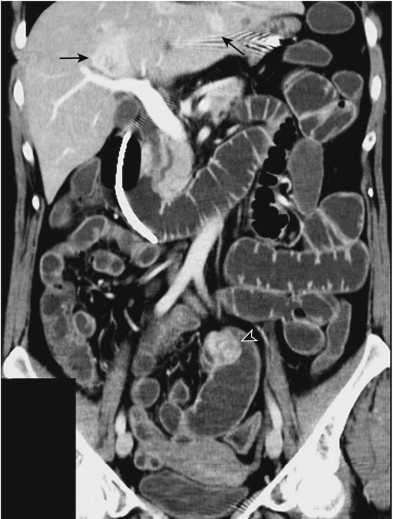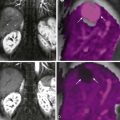Chapter Outline
Gastrointestinal Stromal Tumors
Malignant tumors of the small bowel are rare and account for only 3% to 6% of gastrointestinal (GI) tract malignancies. The most common malignancies include adenocarcinomas, carcinoid tumors, GI stromal tumors, lymphomas, and metastases. The diagnosis of a small bowel neoplasm has been an ongoing challenge for radiologists. Despite almost four decades of surgical and technologic advances in diagnostic modalities, the survival of these patients has not changed, largely as a result of delays in clinical diagnosis. In this chapter, we examine the common small bowel malignancies and evaluate how the radiologist may better diagnose these lesions.
The small intestine represents 75% of the length and 90% of the mucosal surface of the GI tract. Despite this large area of exposure to carcinogens, small bowel neoplasm are uncommon and account for only 3% to 6% of GI neoplasms. Possible reasons for the low prevalence of small bowel cancers include rapid transit time reducing mucosal exposure to carcinogens, a high volume of fluid diluting carcinogens, the absence of bacterial degradation of bile salts, a high proliferation rate and apoptosis of mucosal cells, and immunomodulation by high levels of immunoglobulin A produced by the abundant ileal lymphoid tissue.
Despite advances in diagnostic imaging and operative techniques, the survival of patients with primary malignant tumors has not changed in the last two decades. The main reasons for the absence of survival benefit are delayed diagnosis and lack of novel adjuvant therapies. Patients with small bowel neoplasms often present with nonspecific symptoms such as abdominal pain or GI bleeding. Given the relative rarity of small bowel tumors, physicians have a low index of suspicion. The imaging tests ordered initially, such as fluoroscopic studies and routine abdominopelvic CT, have low sensitivity for small bowel neoplasms, which leads to further diagnostic delay. We will discuss general considerations for the imaging of suspected small bowel neoplasms and then examine the five most common small bowel malignancies—adenocarcinoma, carcinoid tumor, GI stromal tumor, lymphoma, and metastatic tumor ( Table 45-1 ). In diagnosing small bowel malignancies, location in the proximal or distal small bowel is an important differentiating factor.
| Neoplasm | Location | Growth Pattern * | Contrast Enhancement | Obstruction † | Other features |
|---|---|---|---|---|---|
| Cancer ‡ | Periampullary, prox. jejunum | Endoenteric | Variable, usually less than mucosa | Common | Apple core, constricting. |
| Carcinoid | Distal ileum | Endoenteric | Usually intense and homogenous | Rare | Small: often have spiculated mesenteric mass. Hypervascular liver metastases. |
| NHL | Ileum | Exoenteric | Usually = or > than mucosa | Rare | Often large; may show aneurysmal dilation, often with adenopathy. |
| GIST | Jejunum | Exoenteric | Usually intense and homogeneous | Rare | Usually no adenopathy. May show liver or mesenteric metastases. |
* Endoenteric growth is into lumen of bowel, while exoenteric growth is outward into adjacent mesentery.
† Frequency of small bowel obstruction.
The growth pattern of small bowel malignancies may be exoenteric or endoenteric. An exoenteric growth pattern is characterized by extension of tumor into the outer layers of the small bowel wall and mesentery without growth into the lumen, although an extrinsic luminal indentation may be seen. In contrast, an endoenteric growth pattern is characterized by tumor confined to the lumen and bowel wall without extension into the adjacent mesentery. Occasionally, a mixed pattern, with a dumbbell appearance, may be seen. Other imaging features such as the presence or absence of adenopathy, mesenteric masses, or bowel obstruction and the vascularity of liver metastases (if any) help narrow the differential diagnosis.
Imaging Small Bowel Neoplasms
When a small bowel neoplasm is suspected, small bowel enteroclysis or small bowel follow-through has traditionally been performed. These studies are relatively insensitive for the diagnosis of malignant small bowel tumors. In various series, abnormalities were present on small bowel follow-through in 53% to 83% of patients with primary malignant small bowel tumors, but direct evidence of tumor was found in only 30% to 44% of patients. In general, enteroclysis has better accuracy than small bowel follow-through. Nevertheless, a major limitation of enteroclysis is the lack of demonstration of extraintestinal abnormalities.
Techniques that allow for optical visualization of tumors include video capsule endoscopy and double-balloon endoscopy. These techniques are usually performed by GI physicians. Detailed discussions of these techniques have been published. Capsule endoscopy is now routinely performed for unexplained GI bleeding or suspected small bowel disease. It depicts small bowel mucosa very well ( Fig. 45-1 ) but has many limitations, including lack of visualization of submucosal lesions ( Fig. 45-2 ), limited angle of view, susceptibility to becoming lodged at the site of a stricture, incorrect triangulation of the site of disease, and the need to view several thousand images Double-balloon endoscopy allows for sampling of the lesion but is time- consuming and often requires two procedures to evaluate the entire small bowel. This technique has a complication rate of approximately 1.2% to 3.6%, including bowel perforation, has limited availability, and is only used in select cases.
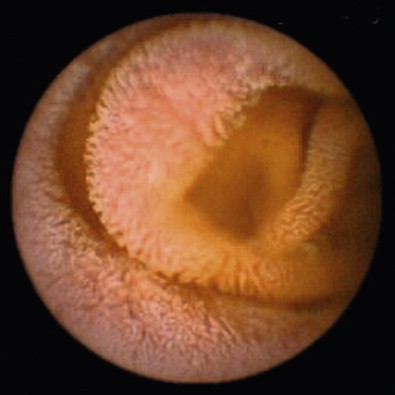
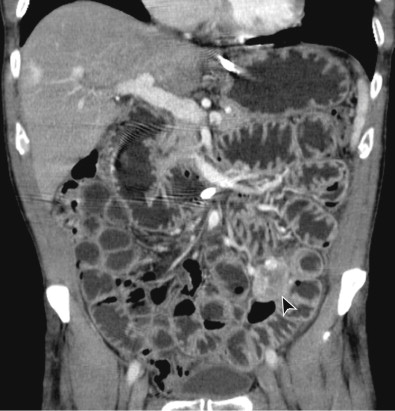
Cross-sectional imaging examinations are not only able to view the mucosa, but also the bowel wall and adjacent mesentery. Dedicated small bowel computed tomography (CT) or magnetic resonance imaging (MRI) techniques may be divided into enteroclysis or enterography procedures. CT enterography has been increasingly used as the first-line investigation in small bowel disease, including Crohn’s disease and small bowel neoplasm. In enterography, 1350 to 2000 mL of enteral contrast is ingested over a period of about 1 hour. In enteroclysis, a tube is placed in the distal duodenum or proximal jejunum and enteral contrast is mechanically pumped into the small bowel using a dedicated hydraulic pump (preferably) or by hand. In CT enteroclysis and enterography, the optimal enteral contrast is neutral contrast—with a Hounsfield density similar to that of water. Water, methylcellulose, mannitol, polyethylene glycol, and a proprietary preparation of 0.1% barium sulfate suspension (VoLumen, E-Z-EM, New York) are used. It is vital to administer an adequate bolus of intravenous (IV) contrast at a rate of 3 to 5 mL/s. Ideally, scanning should be done in at least two phases to include a late arterial phase (scan time to start, ≈35-50 seconds) and venous phase (70- to 80-second delay from contrast injection). Additional delayed phases may help demonstrate that the high density in the lumen is extravasated blood.
MRI enteroclysis or enterography has different types of enteral contrast; the most commonly used contrast in the United States is 0.1% barium sulfate solution. Antiperistaltic agents are commonly administered. If glucagon is used, it is advisable to give 0.5 mg intramuscularly or subcutaneously at the start of the study and then the same dose again before the GI postcontrast phases. The typical MRI enterography-enteroclysis protocol includes coronal T2-weighted, single-shot fast spin-echo (SSFSE) or coronal half-Fourier acquisition single-shot turbo spin-echo (HASTE), and coronal single-shot free precession sequences (e.g., fast imaging employing steady-state acquisition [FIESTA], fast imaging with steady-state precession [FISP], fast field echo [FFE]). Postcontrast coronal, 3D fat-suppressed gradient echo sequences (e.g., volumetric interpolated breath-hold examination [VIBE], liver acquisition with volume acceleration [LAVA], T1-weighted high-resolution isotropic volume examination [THRIVE]) need to be acquired in multiple phases, typically starting 35 seconds after gadolinium injection.
A study of CT enteroclysis reported a sensitivity of 100% for diagnosing small bowel neoplasms ( N = 21). However, because this study did not have a reference standard, such as capsule endoscopy or long-term clinical and radiologic follow-up, it was not possible to ascertain its true sensitivity. A larger study of 219 patients with suspected small bowel neoplasms reported a sensitivity of 85% and specificity of 97% with CT enteroclysis. A prospective MRI enteroclysis study of 150 patients (including 19 with small bowel neoplasms) reported an overall sensitivity and specificity of 86% and 98%, respectively. Another MRI enteroclysis study of 91 patients with suspected small bowel neoplasms found a sensitivity of 91% and 94% for the two blinded reviewers and a specificity of 95% to 97%. It is likely that CT and MRI enteroclysis have a similar accuracy for diagnosing small bowel neoplasms, which is considerably better than that of fluoroscopic studies. CT is faster and better tolerated by ill patients compared with MRI, but has the disadvantage of using ionizing radiation. To our knowledge, there are no prospective or large studies comparing the sensitivity of enteroclysis versus enterography for the diagnosis of small bowel neoplasms. In general, enterography is easier to perform than enteroclysis and is the preferred diagnostic option in most centers.
Adenocarcinoma
The incidence of small bowel adenocarcinoma increased from 5.7/million in 1974 to 7.3/million in 2004. Excluding periampullary tumors, the distribution is approximately 55% in the duodenum, 15% in the jejunum, and 13% in the ileum. There is a distal ileal preference in patients with Crohn’s disease. Tumors in the jejunum have a significantly better survival than those in the ileum.
Adenocarcinoma of the small bowel has risk factors similar to those of colon cancer. Small bowel adenocarcinoma is associated with familial adenomatous polyposis (FAP) and hereditary nonpolyposis colorectal cancer (HNPCC). The generally accepted hypothesis is that adenocarcinoma occurs via an adenoma-carcinoma sequence and that there are mutations in key regulatory genes, such as p53 and k-ras, in a manner similar to that for colon cancer. Other risk factors include Crohn’s disease and celiac disease.
Small bowel adenocarcinoma typically presents as an annular, constricting mass ( Fig. 45-3 ). Less common radiographic features of small bowel adenocarcinoma include a polypoid or ulcerated mass or multiple filling defects. The tumors show heterogeneous enhancement on CT and MRI. Differentiation from active inflammation is important in diagnosing adenocarcinoma in the setting of Crohn’s disease. Features that support the presence of malignancy include lack of mural stratification, asymmetric wall thickening, and a lobulated outer wall surface ( Fig. 45-4 ). Mesenteric vascular congestion is unlikely to be seen in malignancy, unless there is coexisting inflammation. Surgery is the mainstay of treatment for small bowel adenocarcinoma. Adjuvant chemotherapy has been used increasingly, although there are no conclusive data that support its benefit
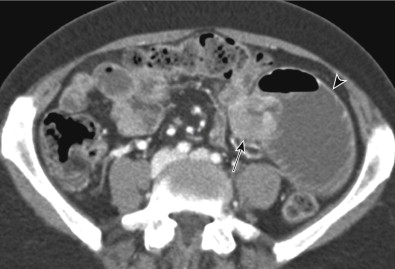
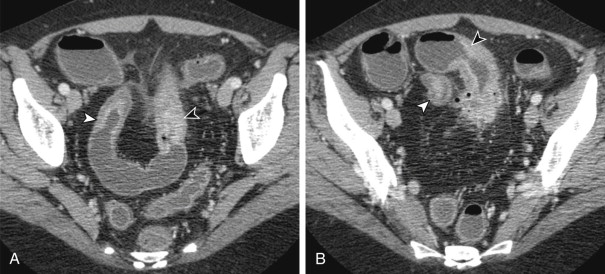
Carcinoid Tumors
The current term for all carcinoid tumors is gastroenteropancreatic neuroendocrine tumors. Surveillance, Epidemiology, and End Results (SEER) database findings on over 67,000 small bowel tumors, recorded over 30 years, have been published. These data show that the incidence of carcinoid tumor increased by 350% from 1974 to 2004. Carcinoid tumor is now considered to be the most common primary malignant lesion of the small bowel, with a slightly higher incidence (37.4% of all cases) than small bowel adenocarcinoma (36.9%). The incidence trajectory of carcinoid tumors, most likely the result of improved imaging technique, may widen this gap in the future.
Carcinoid tumors originate from the ectodermal cells of the neural crest and therefore may occur at any site in which these cells are present, including the GI, pancreatic, biliary, respiratory, and genitourinary tracts and the thymus. Approximately 95% of GI carcinoid tumors occur in the appendix, rectum, and small intestine. About 60% of small bowel carcinoid tumors occur within 40 cm of the ileocecal junction. There are no clear histologic differences between benign and malignant carcinoid tumors. All carcinoid tumors are potentially malignant, with the most important factor being the depth of invasion. Small bowel carcinoid tumors are more aggressive than appendiceal or colonic carcinoid tumors, and may show metastases even when small. Generally, tumors smaller than 1 cm are found to have metastasized 50% of the time, whereas tumors larger than 2 cm are found to have metastasized 95% of the time ( Fig. 45-5 ). Ileal carcinoid tumors usually metastasize to peritoneal surfaces, omentum, lymph nodes, liver, and lungs.

